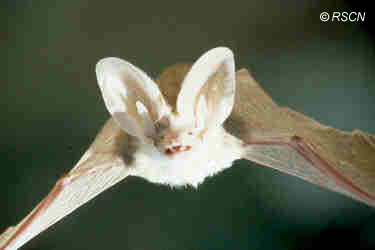Otonycteris hemprichii:
This is a large insectivourous bat with forearm of 62-69 in length and a greatest length of skull or 24-26 mm. Two pairs of nipples occur in this species.The ears are very large as plecotus ears are.
Range of species is the desert regions of northern Africa, Arabia and south-western Asia.
This species was reported from "Lawrence's pool"(near Rum) (BATES & HARRISON 1989, RSCN Fauna team 1999), near Quraiqira (Wadi Fidan) , Disa (Wadi Rum) (Qumsiyeh et al. 1992).
The very unique morphology of this genus with its limited distribution to desert habitats suggests a very specialized biology. Unfortunately little is known of the habits and habitats of this species. The wing morphology (large and broad) and the smooth flight suggests the ability to forage close to the ground. The overall morphology is reminiscent of carnivorous bats (NORBERG & FENTON 1988) and studies on this species are much needed to elucidate its feeding habits.
One specimen from Egypt was caught in a mouse trap also indicating foraging close to the ground. The specimens obtained from Jordan were collected in mistnets set over water pools.

They start their activity Just before dusk, Flying low along rocks, later at evening they observed flying 4-9 m above the Ground. And reported to fly in a circles 20-60 m in diameter and in straight flight without fluttering or quick maneuvers (Cromov et-al ,1928).